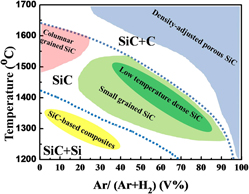Crossref Citations
This article has been cited by the following publications. This list is generated based on data provided by
Crossref.
Zhou, Ping
Zheng, Zujie
Liu, Rongzheng
Liu, Xiaoxue
Liu, Malin
Wang, Taowei
Li, Ziqiang
Shao, Youlin
Zhao, Hongsheng
and
Liu, Bing
2017.
Dual layer SiC coating on matrix graphite sphere prepared by pack cementation and fluidized‐bed chemical vapor deposition.
Journal of the American Ceramic Society,
Vol. 100,
Issue. 8,
p.
3415.
Su, Qing
Wang, Tianyao
Gigax, Jonathan
Shao, Lin
Lanford, William A.
Nastasi, Michael
Li, Liyi
Bhattarai, Gyanendra
Paquette, Michelle M.
and
King, Sean W.
2019.
Influence of topological constraints on ion damage resistance of amorphous hydrogenated silicon carbide.
Acta Materialia,
Vol. 165,
Issue. ,
p.
587.
Zhang, Y.
Wen, M.
Sun, G.X.
Huang, H.
Zhang, S.M.
Wang, M.J.
Zhang, K.
Pang, H.P.
and
Zheng, W.T.
2020.
Insight into microstructural architectures contributing to the tensile strength of continuous W-core SiC fiber.
Journal of the European Ceramic Society,
Vol. 40,
Issue. 15,
p.
5147.
Peng, Jian
Jolly, Brian
Mitchell, David J.
Haynes, J. Allen
and
Shin, Dongwon
2021.
Computational thermodynamic study of SiC chemical vapor deposition from MTS‐H2*.
Journal of the American Ceramic Society,
Vol. 104,
Issue. 7,
p.
3726.
Abyzov, Andrey M.
2022.
Chemical vapor deposition from metal (Cr, Mo, W) carbonyls in a conical spouted bed vacuum reactor with a downflow reactant feeding.
Chemical Engineering Science,
Vol. 260,
Issue. ,
p.
117916.
Yang, Xu
Liu, Rongzheng
Liu, Bing
and
Liu, Malin
2022.
Synthesis of Ultra-Thin Two-Dimensional SiC Using the CVD Method.
Energies,
Vol. 15,
Issue. 17,
p.
6351.
Xiong, Hua
Huang, Rongxia
Long, Ying
Lin, Hua-Tay
Liu, Malin
Liu, Bing
and
Liu, Rongzheng
2022.
Effect of ultra-high temperature treatment on microstructures and mechanical properties of TRISO particles.
Journal of Nuclear Materials,
Vol. 564,
Issue. ,
p.
153701.
Liu, Shuai
Luo, Xian
Huang, Bin
Li, Pengtao
and
Yang, Yanqing
2022.
Role of H2 and Ar as the diluent gas in continuous hot-wire CVD synthesis of SiC fiber.
Journal of the European Ceramic Society,
Vol. 42,
Issue. 7,
p.
3135.
Yang, Xu
Cheng, Xinyu
Liu, Rongzheng
Liu, Zebing
Liu, Bing
and
Liu, Malin
2022.
Preparation and high temperature performance of NbC layer in TRISO particles.
Journal of the European Ceramic Society,
Vol. 42,
Issue. 15,
p.
6889.
Yan, Zefan
Tian, Yu
Liu, Rongzheng
Liu, Bing
Shao, Youlin
and
Liu, Malin
2024.
Atomistic insights into chemical vapor deposition process of preparing silicon carbide materials using ReaxFF-MD simulation.
Computational Materials Science,
Vol. 241,
Issue. ,
p.
113032.
Zhou, Xiang-wen
Hou, Ming-dong
Liu, Rongzheng
and
Liu, Bing
2024.
Fabrication of beryllium oxide based fully ceramic microencapsulated nuclear fuels with dispersed TRISO particles by pressureless sintering method.
Journal of Nuclear Materials,
Vol. 588,
Issue. ,
p.
154798.
Liu, Malin
2025.
Advanced Nuclear Fuels and Materials.
p.
239.
Hu, Linyi
Turner, Joel
Buckley, James
and
Abram, Tim
2025.
A review on properties required for FB-CVD fabricated SiC for TRISO fuel production.
Progress in Nuclear Energy,
Vol. 185,
Issue. ,
p.
105762.



